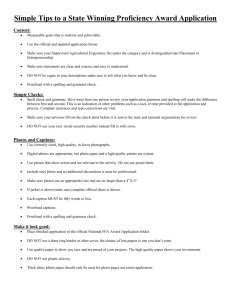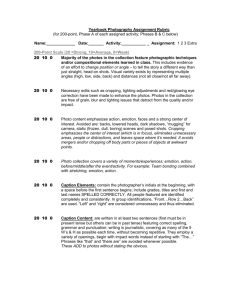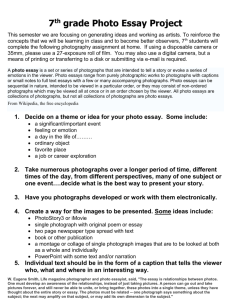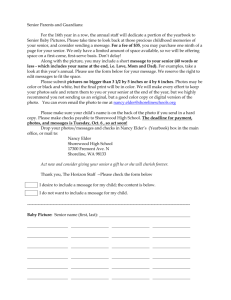Creating a photo essay is a combination of art and journalism
advertisement
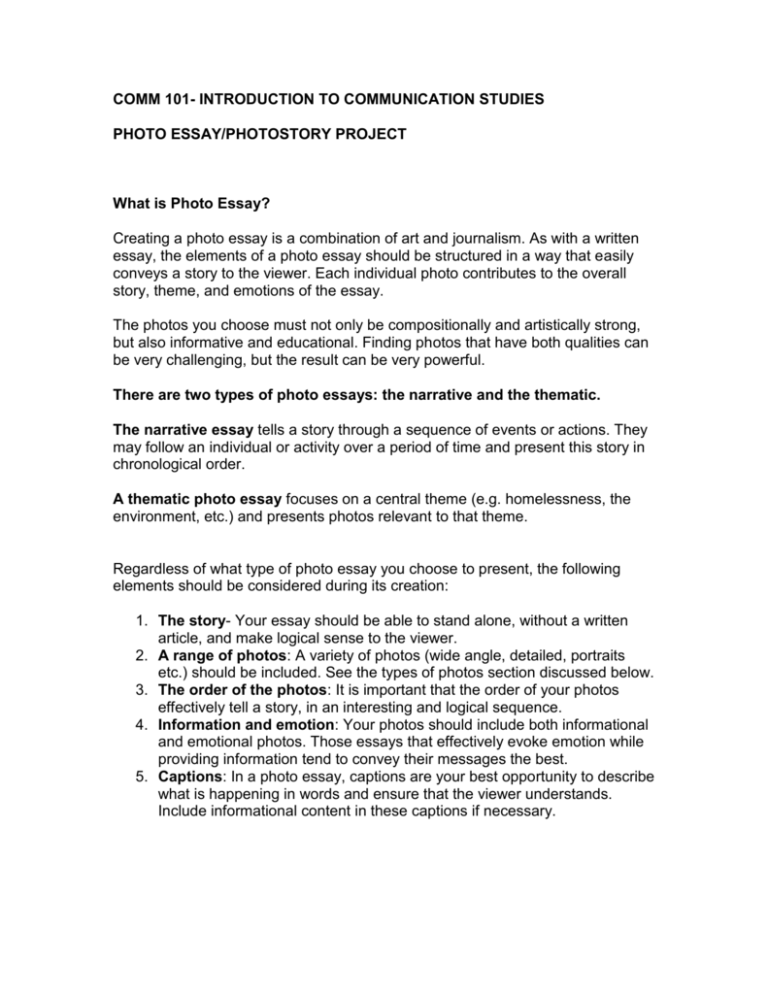
COMM 101- INTRODUCTION TO COMMUNICATION STUDIES PHOTO ESSAY/PHOTOSTORY PROJECT What is Photo Essay? Creating a photo essay is a combination of art and journalism. As with a written essay, the elements of a photo essay should be structured in a way that easily conveys a story to the viewer. Each individual photo contributes to the overall story, theme, and emotions of the essay. The photos you choose must not only be compositionally and artistically strong, but also informative and educational. Finding photos that have both qualities can be very challenging, but the result can be very powerful. There are two types of photo essays: the narrative and the thematic. The narrative essay tells a story through a sequence of events or actions. They may follow an individual or activity over a period of time and present this story in chronological order. A thematic photo essay focuses on a central theme (e.g. homelessness, the environment, etc.) and presents photos relevant to that theme. Regardless of what type of photo essay you choose to present, the following elements should be considered during its creation: 1. The story- Your essay should be able to stand alone, without a written article, and make logical sense to the viewer. 2. A range of photos: A variety of photos (wide angle, detailed, portraits etc.) should be included. See the types of photos section discussed below. 3. The order of the photos: It is important that the order of your photos effectively tell a story, in an interesting and logical sequence. 4. Information and emotion: Your photos should include both informational and emotional photos. Those essays that effectively evoke emotion while providing information tend to convey their messages the best. 5. Captions: In a photo essay, captions are your best opportunity to describe what is happening in words and ensure that the viewer understands. Include informational content in these captions if necessary. Types of Photos By including a variety of types of photos in your essay, you will ensure that it is both interesting and informative. The following types of photos, presented together, can create a successful photo essay. Not only is it important to choose powerful photos, but also to present them in an effective order. While the order of some photos (e.g. the lead photo, and the clincher) is set, the order of most types of photos in your essay is your preference. The Lead Photo: Similar to the first two sentences of a newspaper article, your lead photo should effectively draw in your audience. This is usually the most difficult photo to choose and should follow the theme of your essay. It could be an emotional portrait or an action shot, but ultimately it should provoke the curiosity of the viewer. The Scene: Your second photo should set the stage and describe the scene of your story. An overarching photo taken with a wide angle lens is often effective. The Portraits: Your photo essay should include at least one portrait. Capturing an emotional expression or telling action shot can effectively humanize your story. These photos often evoke strong emotions and empathy in the viewer (whether it is a positive and enthusiastic emotion, or a sympathetic and concerned emotion.) The Detail Photos: Detail photos focus in on one element, be it a building, a face, or a relevant object. These photos are your best opportunity to capture specific objects. The captions of these photos should be informative and educational. The Close-up Photos: Similarly, close-up photos provide an opportunity to focus in on specific objects. These photos are tightly cropped, simple shots that present a specific element of your story. Again, this is an excellent opportunity to present information in the caption. The Signature Photo: The signature photo summarizes the situation and captures the key elements of your story in a telling moment. The Clincher Photo: The final photo, the clincher, should evoke the emotion you want the viewer to walk away with, be it a feeling of hope, inspiration, or sadness. Decide on this mood before you select this photo. Remember, these suggestions are only guidelines. Photo essays are a form of art, and like any artistic creation, breaking the rules can sometimes create the most powerful result. Don’t be afraid to try something different. Beginning activities with photo-essays The combination of strong writing with intriguing photographs makes for a powerful teaching tool. You might consider using the photo-essay in part, perhaps using the photographs without the text. Try to write captions for the photographs. Use the photographs as story starters: what would you title this picture? What happened just before this picture was taken? What will probably happen next? Look at the photographs: What do they need/want to know to understand the photograph better? What questions are raised by the photograph? What questions does it answer? Making your own photo-essays Planning: Plan your topic as you would with any piece of writing. What is your topic? What is your purpose? Who is your audience? What pictures do you plan on taking? (It's a good idea to set minimum and maximum number of pictures for the essays) Storyboards: Create a storyboard in which should put how your pictures will follow Taking the Pictures: Take your photographs by using your storyboards Once you have selected the best photos suitable for your project work on the accompanying narrative to edit your pictures. Final Steps: Use MOVIEMAKER to edit your pictures, you can add titles and sound (music, sound effects etc.) to your project


